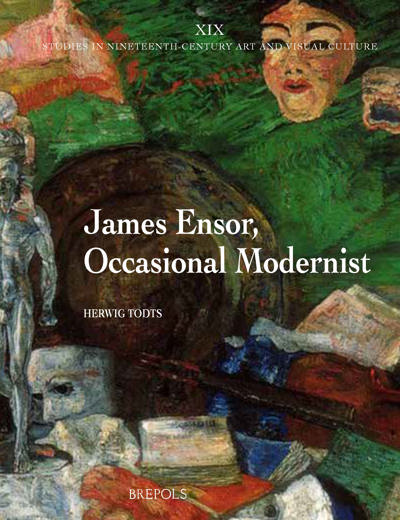
Antoine Wiertz (1806–65)
And the Quest for Modern Genius
Bram van Oostveldt, Stijn Bussels, Caroline Van Eck (eds)
- Pages: iv + 164 p.
- Size:216 x 280 mm
- Illustrations:1 b/w, 67 col.
- Language(s):English
- Publication Year:2025
- € 95,00 EXCL. VAT RETAIL PRICE
- ISBN: 978-2-503-60473-2
- Hardback
- Available
The first part of this book studies the oeuvre of the Belgian Romantic painter Antoine Wiertz (1806-1865) within an international art historical context, while the second part focuses on the Musée Wiertz as one of the earliest examples of the artist museum.
Bram Van Oostveldt is Professor at the Department of Art, Music – and Theatre Studies at Ghent University. Previously, he worked at the University of Amsterdam and at Leiden University. He focuses on seventeenth, eighteenth and nineteenth-century theatre in relation to the visual arts. In 2013, he published a monograph on Brussels theatre in the eighteenth century (Verloren). With Stijn Bussels, he co-authored The Sublime in the Visual Culture of the Seventeenth-Century Dutch Republic (Routledge, 2023). He is currently leading a research project on theatre and camouflage.
Stijn Bussels is Professor of Art History before 1800 at Leiden University and director of the research center LUCAS (Leiden University Centre for Arts and Society). His books include The Antwerp Entry of Prince Philip in 1549: Rhetoric, Performance and Power (Rodopi, 2012) and The Animated Image: Roman Theory on Naturalism, Vividness and Divine Power (Akademie Verlag, 2012). With Bram Van Oostveldt he co-authored The Sublime in the Visual Culture of the Seventeenth-Century Dutch Republic (Routledge, 2023). He was the Principal Investigator of the ERC starting grant program ‘Elevated Minds. The Sublime in the Public Arts in Seventeenth-Century Paris and Amsterdam’ (2013-18).
Caroline van Eck is Professor of Art History at the University of Cambridge. Her work focuses on architectural history and theory, early modern art and its effect on humans. She received a VICI research grant for her project ‘Art, Agency and Living Presence Responses in Early Modern Italy’. Her publications include Classical Rhetoric and the Visual Arts in Early Modern Europe (Cambridge University Press, 2006) and Art, Agency and Living Presence: from the Animated Image to the Excessive Object (De Gruyter, 2015). In 2023 she published Piranesi’s Candelabra and the Revival of the Past. Excessive Objects and the Emergence of Style in the Age of Neoclassicism (Oxford University Press, 2023). Currently, she directs a research project on Art and Camouflage. In 2015 she was made a Chevalier of the Ordre National du Mérite, and in the same year she received the Grand Prix du rayonnement de la littérature et culture française, awarded by the Académie française. She was elected to the British Academy in 2020.
This book offers a fresh look at Antoine Wiertz (1806–65), a Belgian artist often called a ‘failure,’ and uncovers his fascinating complexity. Leading experts explore Wiertz’s early influences, his use of the grotesque, and his innovative ideas about artist’s museums. The essays examine his struggles with Neoclassicism and the Parisian art scene, his fascination with death and his sculptural oeuvre. They also reveal links between Wiertz’s art, politics, and the development of 19th-century Belgium. With new research, the book illuminates his unique way of creating and showing art. This analysis shows that Wiertz was a major player in debates on what makes an artistic genius. ‘Antoine Wiertz and the Quest for Modern Genius’ reclaims his significance, and encourages a renewed appreciation of his oeuvre in art history. Essays by Dominique Marechal, Stephen Bann, Caroline van Eck, Hanneke Grootenboer, Marc Gotlieb, Pascal Griener, Maarten Liefooghe and Bart Verschaffel.
Introduction
Bram van Oostveldt, Stijn Bussels, and Caroline van Eck
I. The Formation of an Artist
Becoming Wiertz: The Early Years (1820–37)
Dominique Marechal
Embattled Classicism
Stephen Bann
II. Wiertz and the Aesthetics of the Grotesque
Boring Modernism? Wiertz’s Sculptures
Caroline van Eck
Wiertz’s Philosophical Paintings
Hanneke Grootenboer
M Stands for Mort: The Last Hours of Antoine Wiertz
Marc Gotlieb
III. Wiertz and the Museum
Artists’ Museums: A Symbolical Form in the History of Culture
Pascal Griener
Spectacles Full of Lessons or Performances for Posterity? The Musée Wiertz Contrasted with the Musée Gustave Moreau
Maarten Liefooghe
The Case of Antoine Wiertz: Art and/or Politics?
Bart Verschaffel
Index of Names
Author Biographies




